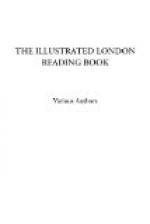The lowermost sail of the mast, called thence the mainsail, or foresail; the topsail, carried by the topsail-yard; the top-gallant-sail; and above this there is also set a royal sail, and again above this, but only on emergencies, a sail significantly called a sky-sail. Besides all this, the three lowermost of these are capable of having their surface to be exposed to the wind increased by means of studding sails, which are narrow sails set on each side beyond the regular one, by means of small booms or yards, which can be slid out so as to extend the lower yards and topsail-yards: the upper parts of these additional sails hang from small yards suspended from the principal ones, and the boom of the lower studding-sails is hooked on to the chains. Thus each of the two principal masts, the fore and main, are capable of bearing no less than thirteen distinct sails. If a ship could be imagined as cut through by a plane, at right angles to the keel, close to the mainmast, the area, or surface, of all the sails on this would be five or six times as great as that of the section or profile of the hull!
The starboard studding-sails are on the fore-mast, and on both sides of the main-top-gallant and main-royal; but, in going nearly before a wind, there is no advantage derived from the stay-sails, which, accordingly, are not set. The flying-jib is to be set to assist in steadying the motion.
The mizen-mast, instead of a lower square-sail like the two others, has a sail like that of a cutter, lying in the plane of the keel, its bottom stretched on a boom, which extends far over the taffarel, and the upper edge carried by a gaff or yard sloping upwards, supported by ropes from the top of the mizen-mast.
All these sails, the sky-sails excepted, have four sides, as have also the sprit-sails on the bowsprit, jib-boom, &c.; and all, except the sail last mentioned on the mizen, usually lie across the ship, or in planes forming considerable angles with the axis or central line of the ship. There are a number of sails which lie in the same plane with the keel, being attached to the various stays of the masts; these are triangular sails, and those are called stay-sails which are between the masts: those before the fore-mast, and connected with the bowsprit, are the fore stay-sail, the fore-topmast-stay-sail, the jib, sometimes a flying jib, and another called a middle jib, and there are two or three others used occasionally. Thus it appears that there are no less than fifty-three different sails, which are used at times, though, we believe, seldom more than twenty are set at one time, for it is obviously useless to extend or set a sail, if the wind is prevented from filling it by another which intercepts the current of air.




